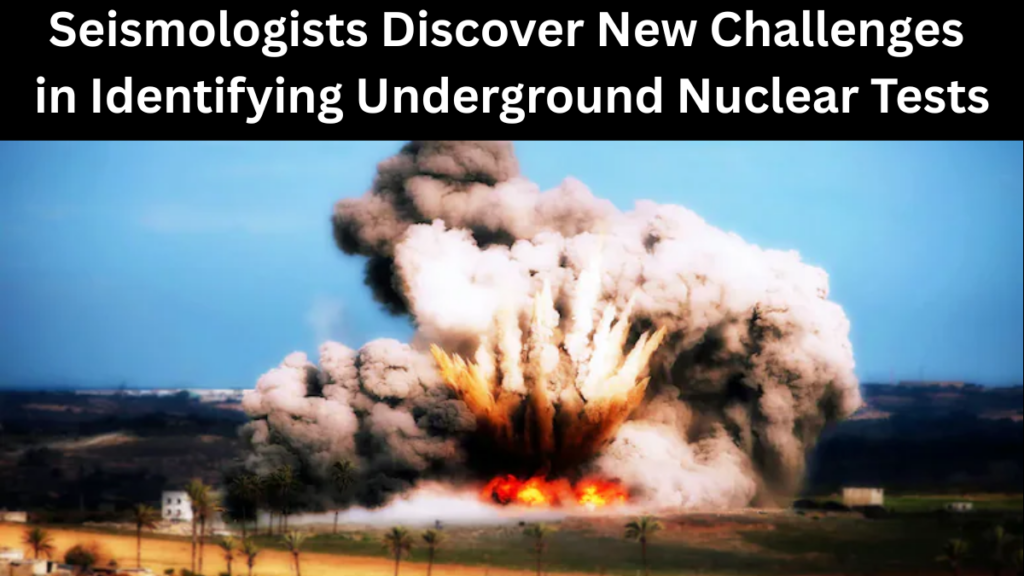A recent study by seismologists at Los Alamos National Laboratory has revealed that detecting underground nuclear tests might be even more complicated than we thought. In fact, earthquakes could potentially be masking these tests, making it harder for experts to differentiate between natural seismic events and covert nuclear explosions.
This groundbreaking research, led by Joshua Carmichael and published in the Bulletin of the Seismological Society of America, sheds light on the challenges faced by the scientific community in detecting nuclear tests.

The Hidden Challenge: Nuclear Tests vs. Earthquakes
When an underground nuclear test occurs, it creates seismic waves similar to those produced by natural earthquakes. This similarity in waveforms has long made it difficult for monitoring systems to detect these tests. While advancements in seismic monitoring technology have helped, they have not completely solved the problem.
Key Differences in Seismic Signals:
-
Earthquakes: Earthquakes produce a mixture of P-waves (compressional waves) and S-waves (shear waves).
-
Nuclear Tests: Explosions from nuclear tests generate more P-waves compared to S-waves.
By analyzing the ratio of P-waves to S-waves, scientists have improved their ability to distinguish between natural seismic events and nuclear tests. However, the challenge of detection remains.
New Insights into Detection Technology
The study by Carmichael and his team uncovered some alarming findings. They used advanced signal detection technology, which boasts a 97% success rate in identifying small underground explosions (as small as 1.7 tons). However, when seismic signals from an explosion overlapped with the signals from an earthquake happening nearby—within 100 seconds and 250 kilometers away—the success rate dropped drastically to just 37%.
The Masking Effect
Even with the most sensitive detectors available, overlapping seismic signals from earthquakes and explosions often “mask” the explosion, making it nearly impossible to identify. As Carmichael explained, “The overlapping waveforms obfuscate the ability of even the most sensitive digital signal detectors to identify that explosion.”
This discovery challenges previous assumptions, including a 2012 report that concluded earthquake signals couldn’t cover up explosion signals. The new findings suggest that the possibility of “explosion masking” by natural seismic signals is more common than initially thought, especially in regions with significant seismic activity.
Seismic Activity in North Korea
One of the more concerning aspects of the study is the implications for global nuclear test monitoring. In North Korea, which has conducted six nuclear tests in the past two decades, increased regional seismic activity is now being observed. Carmichael notes, “There’s been a lot more low-magnitude seismicity near test sites than we initially realized.” This means that natural seismic events could be interfering with the detection of nuclear tests.
Impact on Earthquake Detection
The researchers also found that seismic signals from earthquake swarms or aftershock sequences could be hidden in the same way, leading to a dramatic decrease in detection rates. In cases where natural seismic events overlap with explosions, detection rates dropped from 92% to just 16%.
Carmichael suggests that this could mean we are underestimating the number of low-magnitude earthquakes occurring during swarms or aftershock sequences. This revelation could have broader implications for how we monitor seismic activity and assess global earthquake data.
Conclusion:
The implications of these findings are significant for both nuclear test monitoring and earthquake detection. With overlapping seismic signals becoming more of an issue, experts may need to rethink how they analyze seismic data in areas with frequent seismic activity.
Frequently Asked Questions (FAQs)
1. What is explosion masking?
Explosion masking refers to the phenomenon where seismic signals from underground nuclear tests are hidden or obscured by the seismic signals from natural earthquakes. This makes it difficult to detect the explosion.
2. How do P-waves and S-waves help in detecting nuclear tests?
P-waves and S-waves are types of seismic waves. Nuclear tests typically generate more P-waves than earthquakes, which can help experts distinguish between the two. Analyzing the ratio of these waves can improve detection accuracy.
3. Why is it hard to differentiate between earthquakes and nuclear tests?
Both earthquakes and nuclear tests produce similar seismic signals. The overlapping waveforms of natural seismic events and nuclear explosions can “mask” the detection of an explosion, making it difficult for monitoring systems to identify the test.
4. How does seismic activity in North Korea affect nuclear test detection?
In regions like North Korea, where there has been significant seismic activity near nuclear test sites, natural earthquakes could obscure the signals of underground nuclear explosions, reducing the ability of monitoring systems to detect these tests.
Click here to learn more
Sachin is a dedicated writer specializing in education, career, and recruitment topics, delivering clear and actionable insights to empower readers.
